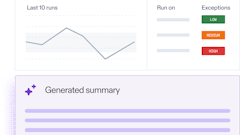Miami and London—May 14, 2014—Procurement leaders are expanding their priorities for 2014, moving beyond a historic emphasis on reducing purchase costs and adding focus on expanding and deepening the scope of spend influence as well as supporting supplier-led product innovation, according to 2014 Procurement Key Issues research from The Hackett Group, Inc.
The Hackett Group's research reveals a major change in procurement's priorities from last year, when cost reduction/avoidance was their No. 1 concern. Over three quarters of the executives placed this first in their priority ranking. Tapping into supplier innovation is the second-highest priority and a focus for 69 percent of the companies in the study. Prioritization levels for both of these issues increased significantly from 2013. Despite its historic position as a top focus, only about half of the companies said they were focusing on cost reduction and avoidance in 2014 as a key procurement strategy, placing it fourth on their priority list.
The Hackett Group's research also showed that procurement leaders are expecting to see small increases in budgets and staffing in 2014. Budgets are expected to increase by 0.7 percent and staffing by 0.9 percent. But the expected enterprise growth rate of 6.7 percent will far exceed both of these increases, resulting in a productivity and efficiency gaps of about 6 percent for 2014.
"Overall, companies are turning to innovation to drive revenue growth and margin improvements in 2014," said The Hackett Group Global Managing Director and Procurement Advisory Practice Leader Chris Sawchuk. "Cost reduction is still a top priority. But we believe many procurement organizations have reached the upper limit of cost reductions possible in categories they are actively sourcing today. So they're looking for ways to reinvent their value proposition. A key part of this is expanding their influence, and taking a life-cycle approach to category management. This requires working more effectively with spend owners, executives, requisitioners, suppliers, and other stakeholders. It also calls for skills that are outside procurement’s traditional areas of expertise."
According to The Hackett Group's research, procurement should focus its transformation efforts in three areas to achieve the biggest enterprise impact in 2014: rebalancing supply risk; recalibrating procurement technology and tools; and reinventing procurement's value proposition.
Rebalancing supply risk
Procurement organizations must recharge their risk management and mitigation efforts in 2014, The Hackett Group's research recommends. Even among top-performing procurement organizations, only slightly more than half conduct formal supply-base risk assessments, The Hackett Group found. The main focus of procurement's risk mitigation efforts are on trying to identify signs of financial distress among suppliers, evaluating alternative sourcing arrangements, and running what-if scenarios to identify supply network risks and build resiliency.
The Hackett Group's research identified several emerging risk mitigation areas where procurement organizations are beginning to focus as part of their supply chain strategy. Supplier data security—ensuring that suppliers are able to keep sensitive data private—is one area that is being addressed by procurement organizations in several ways. Procurement organizations are considering the need to pre-qualify suppliers' ability to handle sensitive data. They are beginning to work with IT to understand data-security compliance issues. Finally, they are seeking to balance an expanded risk management role with the need to foster supplier innovation, better understanding the tradeoffs between supplier risk and innovation potential.
Recalibrating procurement technology and tools
With only limited new procurement-related technology spending in 2014, procurement leaders are focusing on reconfiguring or extending existing applications to improve their value. Enhancing the quality of inputs is one way to do this, and as a result driving master data management is the principal technology priority for 2014, according to The Hackett Group's research. Another top technology focus for procurement in 2014 is implementing business intelligence and analytics applications, to facilitate automated spend analysis as well as other efforts to extract valuable insights from the massive amounts of data that are available, and gain strategic sourcing insights.
New for 2014 is a higher level of attention to self-service and collaborative tools by procurement. Over half the companies in The Hackett Group's study said they intend to roll out Web-based and self-service tools for internal employees. In addition, the research found procurement leaders hoping to significantly expand their use of peer networks to share supplier risk and performance information, and also collaborate with suppliers on demand forecasts.
Reinventing Pprocurement's value proposition
The Hackett Group's Key Issues Research also found that the importance of monitoring, measuring and reporting on procurement’s value contribution is on the rise for 2014, as companies seek to quantify and communicate the value procurement delivers. A total of 75 percent of all companies ranked value contribution visibility as a key procurement investment area for 2014, and another 69 percent ranked investments in measuring and monitoring their value contribution as a key objective.
But increasing and measuring spend influence should only be the first step in quantifying value contribution. The Hackett Group's research suggests that procurement leaders should consider what impact enterprise-level innovation-based strategies will have on procurement and how to measure their value against that goal. This could include improvements in requirements engineering, the number of truly new solution proposals that procurement brings to the table, or a consideration of whether the resulting products or services ever make it to the market.
"To bring clarity to the discussion, procurement must know how to document its own innovation and the impact it has on enterprise growth and be able to convince the rest of the organization that procurement’s expanded value proposition is real," said Mr. Sawchuk. "Unquestionably, the process of broadening value objectives, scorecards and capabilities will be arduous. More than brute force, flexibility is of the essence to help the procurement organizations expand globally in step with the business."
The Hackett Group's 2014 Procurement Key Issues research is based on a study conducted in late 2013. Study participants included executives from over 150 large companies in the US and abroad, on their business strategies, revenue and budget expectations, and key initiatives for 2014. A complimentary copy of The Hackett Group's research insight, "Rethinking How Procurement Defines Its Value, Balances Risk and Gets the Most from Technology Investments," is available with registration at this link: http://www.thehackettgroup.com/research/2014/pr/keyissues-pr/.















![Pros To Know 2026 [color]](https://img.sdcexec.com/mindful/acbm/workspaces/default/uploads/2025/08/prostoknow-2026-color.mduFvhpgMk.png?ar=16%3A9&auto=format%2Ccompress&bg=fff&fill-color=fff&fit=fill&h=135&q=70&w=240)

